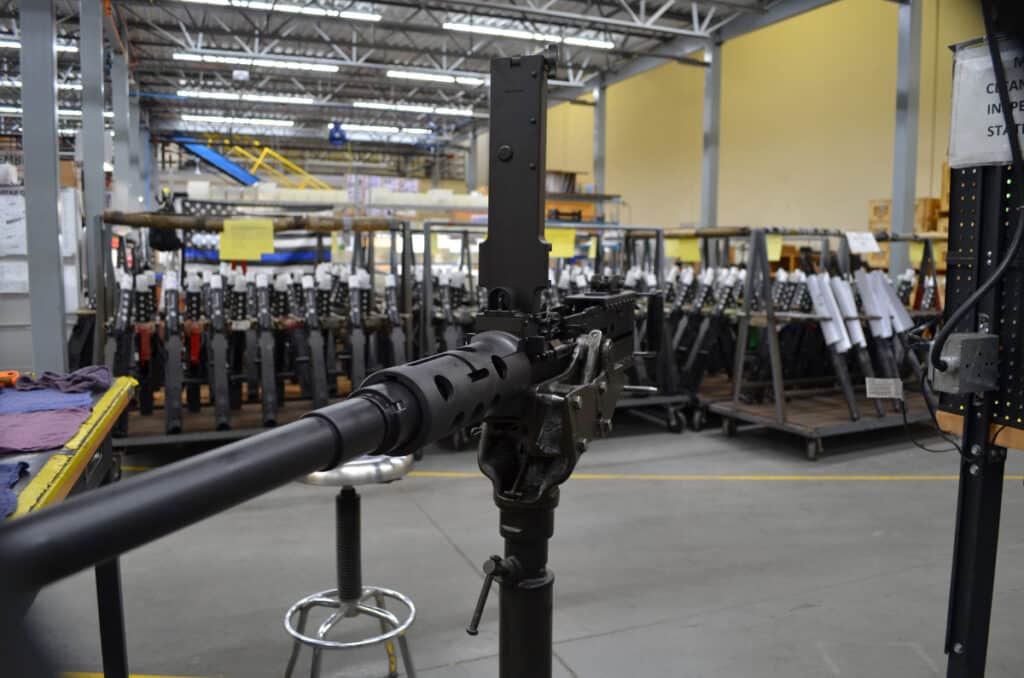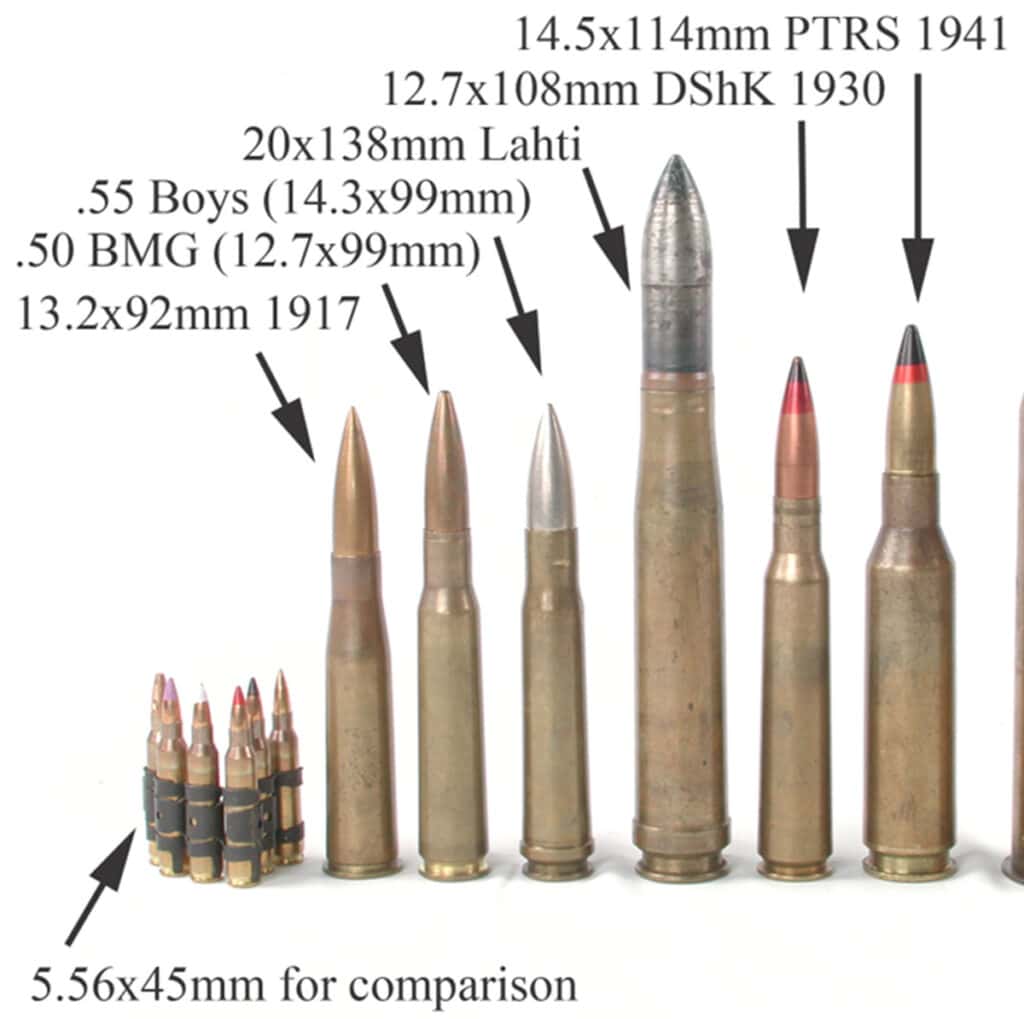By Dan Shea –
At the end of the World War I, that “War to End All Wars,” there were many lessons learned about the weapons and threats that would be encountered. This was a new kind of war; machine guns, armored vehicles, aircraft, Zeppelins, and underwater craft were among the evolving threats. The U.S. military called once again on the great John Moses Browning, weapon designer extraordinaire, to produce a new heavy machine gun round to counter the new threats. There are different theories on how Browning arrived at the .50 BMG cartridge; one camp believes he simply upsized the U.S. 30.06 cartridge; another that he scaled up the German 1918 13.2x92mm anti-tank cartridge. In truth, it was a combination of both. By 1921, Browning had developed the .50 BMG cartridge as well as the M2 machine gun and its link system; these are still in use today, a century later. There are improvements, of course. The guns went from water-cooled to air cooled, and refinements were made to the cocking system and mounts, but this long-lived system is still on the front lines around the world today.

As an aside, gunners are taught to reach up under the retracting charging handle and pull it to the rear, as opposed to reaching over the top, wrist behind the handle. It’s widely believed this method gives better leverage, but that’s not the real reason. Browning’s first designs had a “bottle” charging handle that was directly in the bolt and traveled with the bolt, and if the operator reached over the top to charge and the cartridge fired, it could break the operator’s wrist in recoil. The retracting charging handle was designed to separate the functions. There is a stud that is in the bolt, and the new charging system pulls that to the rear. If there is an accidental firing while the operator holds the handle, the bolt goes to the rear, but the handle is disconnected. No broken wrist. In the ensuing century, there have been many modifications such as this, but the core system, the M2 Heavy Barrel machine gun, “Ma Deuce,” is still with us.

The major issue with the system, the biggest operator malfunction, and an issue since day one, is that the barrel is removed and installed by the operators in the field and need to be properly gauged before firing. This requires a set of headspace and timing gauges, as well as proper training. It also takes a significant amount of time to do this properly, especially under pressure in combat. Threading the barrel in and out, and headspacing and timing as needed, is an operator distraction. Most machine gunners know their guns, and develop little tricks to shortcut the system. But unless they’ve been taught to “read the brass” and properly headspace and time the gun, those shortcuts don’t equal proper field performance.

Enter the quick-change barrel (QCB) concept. There have been many attempts at this, a few successful. All share two things; first, interrupted threads where the barrel locks to the extension, and second, a method of guiding the barrel in correctly and rotating into position, which is done with a pin.
What style of QCB system is in our inventory?
This is a very important question for those in procurement who already have some M2 QCB machine guns in their inventory.
Essentially, whether the pin is on the barrel or on the barrel support designates what basic style of QCB you have. The U.S. DoD-adopted system is the M2A1, and the pin is on the barrel with a guiding slot in the barrel support. The other systems where the pin is part of the barrel support and the guiding slot is in the barrel are variants of the M2A2. Look to the photos to further identify which system you have if you are matching new orders or adding support parts.

The strength of the pins used in all systems are an issue, and how to repair them if damaged. The basic M2A1 pin diameter is .376 inches, and it is installed into the barrel as shown in the M2A1 photos. The M2A2 pin diameter is .446 and it is a replaceable part in the barrel support. So, if damaged, this is easily repaired at the depot level. For the M2A1, they use a TIG system to install the guidance pin in the barrel well. Because of the apparent issue with M2A1, barrel pins being damaged by exuberant and perhaps not so observant operators, U.S. Ordnance can repair existing barrels by installing a new stud, but they’ve also come up with a solution for government consideration. A pin of the same diameter and height is used, but it has a wider base and a not so radical 90-degree angle at its base. It has a much more supportive radius, and is more robust and should limit the damage done by improper assembly of the M2A1 systems. The M2A2 and M2A2-N do not suffer from an issue here, as stated, the guidance pin is replaceable in the barrel support.
As another aside, if the barrel guidance pin is removed from the barrel support of the M2A2 system, regular M2HB barrels can be used in the system for in an emergency or training scenario.

Manroy Engineering, FN Herstal, General Dynamics, Ohio Ordnance Works, and U.S. Ordnance have all been manufacturers of variants of QCB. I’ve had the pleasure of working with all of the above over the years, testing the firearms, and there are many fine products. That said, on my recent visit to U.S. Ordnance in the Reno, Nevada area, I confirmed that US Ordnance is in production and support of all of the QCB variants, and is the U.S. DoD contractor supplying the U.S. M2A1 to the U.S. military and allies with foreign military sales or private purchase contract ability. They can fill orders for new guns, provide rebuilds, and repair/support parts with almost any .50 BMG variant. Thus, this report has focused on information gained at the U.S. Ordnance facility.
During the tour of its manufacturing facility, U.S. Ordnance employee Beaux Armand explained the full testing procedure. Most impressive is the requirement to build ten guns, run them through all gauging, testing and cleaning, then completely disassemble all ten, mix the parts and then gauge and test again. All ten guns must pass this rigorous acceptance testing. More about the gauging is in the accompanying photos and captions.
We at SADJ hope this look into the QCB world of .50 caliber machine guns helps you to understand what’s on the market, properly identify what may be in your inventory, and answer the questions you might have. I’m available regarding serious enquiries on technical issues, as always, at info@chipotlepublishing.com. U.S. Ordnance can be contacted for further information at sales@usord.com.





















